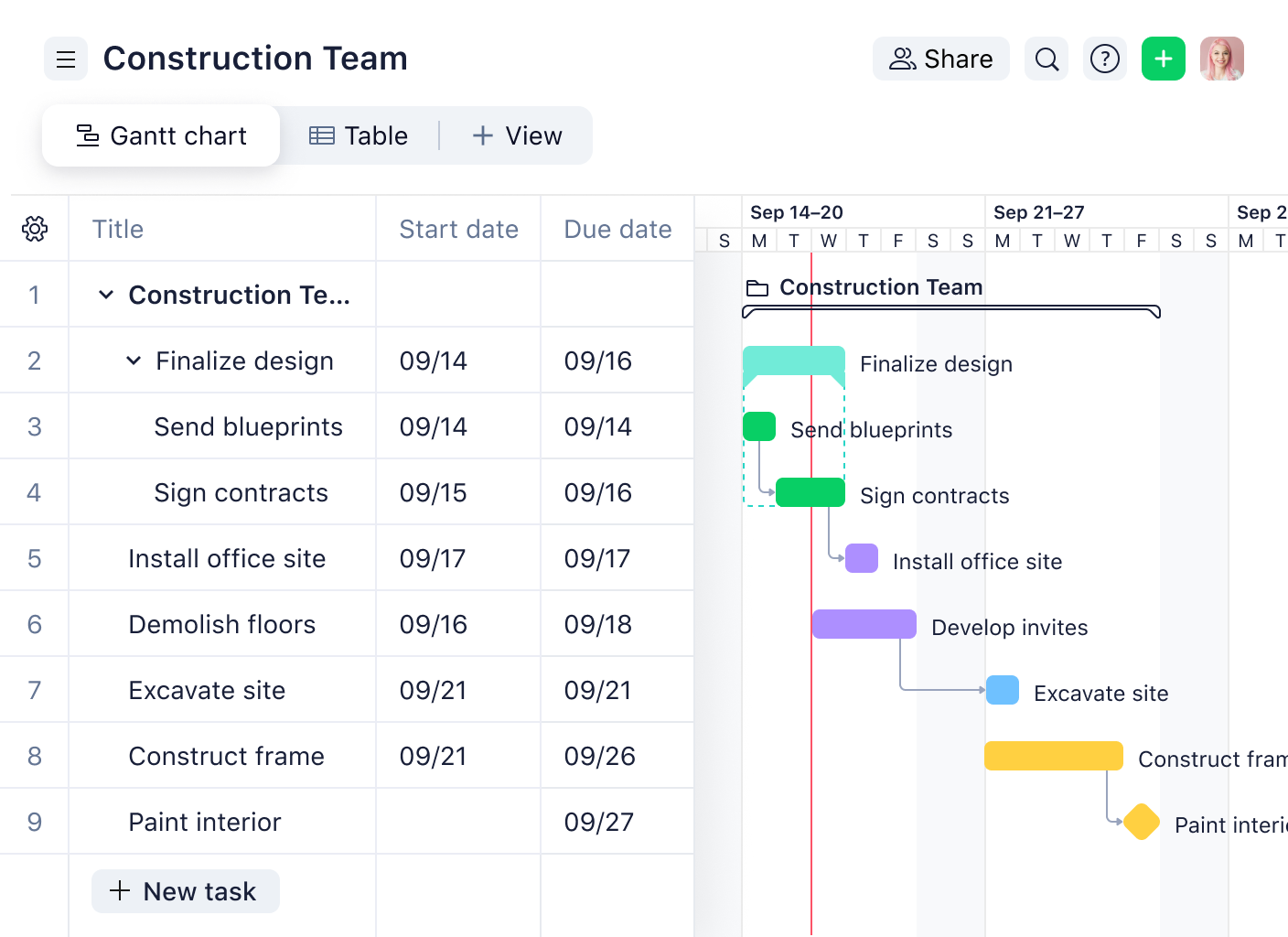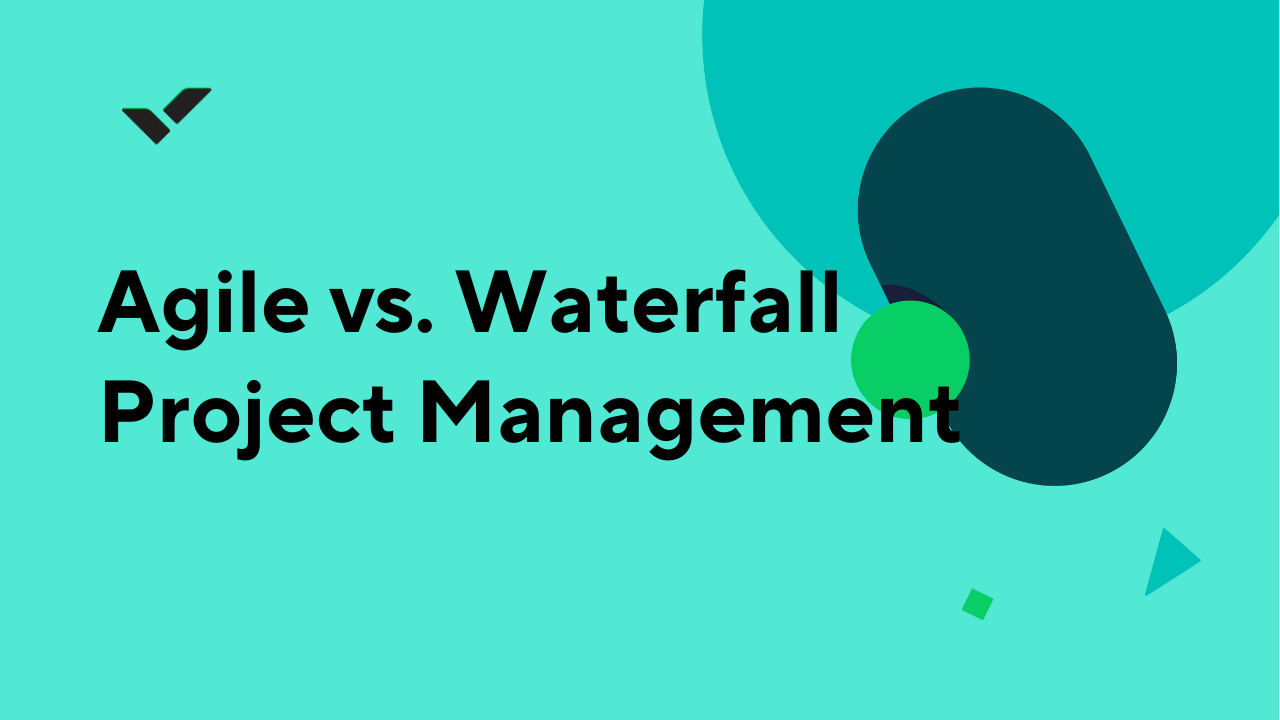Agile vs. Waterfall - Key Differences

You’re about to kick off a new project and you’d like to follow a specific framework to keep things organized. Which project management framework will you choose? A structured Waterfall model where everything is planned from the start, or an Agile method that thrives on flexibility and continuous improvement?
Keep reading to discover the Agile and Waterfall difference. You’ll determine which methodology best suits your project’s needs and how project management software like Wrike can help you manage your choice effectively.
Build your workflow in Wrike, whether Agile or Waterfall — start your free trial now.
What is Agile project management?
Agile project management is a dynamic and iterative approach that focuses on continuous improvement, flexibility, and high levels of team involvement. In this methodology, project plans evolve through the collaborative efforts of cross-functional teams and other stakeholders.
Based on the famous Agile Manifesto, the Agile framework is designed to accommodate changes and feedback quickly, typically through regular feedback loops that help refine and improve the development process.
The diagram below perfectly illustrates the Agile project management cycle, highlighting its iterative and collaborative nature.

Pros of Agile
- Quickly adapts to changes in scope or project plan
- Frequent updates keep customers and product owners engaged
- Early and frequent testing enhances product quality
- Keeps all team members actively involved
- Speeds up delivery through iterative cycles
- Early problem detection lowers failure risks
Cons of Agile
- Flexibility can lead to constant changes, impacting budget and timeline
- Outcomes are less certain without a fixed project plan
- Requires a lot of time and commitment from development teams
- Effective management requires experienced Agile leaders
- Less effective for projects with static, defined requirements
Ready to plan your Agile sprints with Wrike?
What is Waterfall project management?
Waterfall project management is a sequential process where fixed, defined requirements are identified early in the project process. This methodology involves progressing through a series of distinct phases — concept, initiation, analysis, design, construction, testing, implementation, and maintenance — with each phase completed before the next begins.
The diagram below shows a clear view of the Waterfall project management process, using a Gantt chart to map out each sequential phase from concept to deployment.

Pros of Waterfall
- The process is straightforward and easy to understand
- Fixed plans make it easier to predict project outcomes
- Projects with well-defined phases facilitate better progress tracking
- All requirements are defined upfront, minimizing scope creep
- Maintains detailed records, aiding future maintenance
- For some types of projects, especially where integration with other non-Agile systems is required, Waterfall may offer better control
Cons of Waterfall
- Difficult to make changes once a phase is completed
- Final products may not meet user needs
- Requires a lot of resources in the early stages
- Not suitable for rapidly changing environments
- Testing late in the process can lead to costly fixes
Prefer a more traditional approach? Wrike’s got you covered.
What is the difference between Agile and Waterfall?
The main difference between Waterfall and Agile is that the former offers a more traditional approach to project management, involving a linear flow. Agile, on the other hand, embraces an iterative process with rapid actions and great flexibility.
Let’s look at a comparative table to better illustrate the practical applications and outcomes of Waterfall vs. Agile in real-world settings. This table details specific examples, showing how each approach is applied and what outcomes can typically be expected.
Examples of Agile vs. Waterfall project management
Imagine you’re in charge of a tech startup developing a mobile app. For your team, an Agile framework would be useful. By using iterative sprints to develop core functionalities and add regular user feedback, your app can evolve with new features that satisfy user needs and help maintain competitiveness in the market.
What if you work with government software for public records? In this case, a Waterfall approach would be the best fit. Be sure to follow a strict sequence from requirements gathering to maintenance, so that the phases don’t overlap. At the end, you can successfully deliver a system that meets fixed requirements and regulations and adheres to the highest of standards.
Or perhaps, your speciality lies in e-commerce website redesign. Agile will be your best friend here. Using this methodology, you can oversee rapid prototype releases, with frequent revisions based on A/B testing and user analytics. The result? A continuously improving website that adapts to consumer behavior and feedback to boost user engagement and sales.
Now, picture yourself working on the construction of a new corporate office. It’s time to use the Waterfall framework, where you and your team follow a precise blueprint. Ensure that every project phase is carefully detailed, from architectural design to construction. Ideally, your project will be completed as planned, with minimal deviations and all predefined specifications met.
Lastly, for those tasked with leading a marketing campaign for a new project, the Agile technique would be a good match. With this approach, you can make quick campaign adjustments based on real-time data on customer satisfaction and engagement. You’re aiming for a campaign that remains relevant and maximizes ROI through agility in strategy and execution.
You can watch the video below for an in-depth comparison of the Agile model vs. Waterfall model.

Video transcription
“When learning project management methodologies, you may have wondered at one time or another what the better approach truly is: Agile or Waterfall? Though Agile and Waterfall’s processes and structures are very different, they’re both valid approaches to project management. Agile projects are often open to change and represent an iterative approach to product development. Waterfall, on the other hand, represents a more straightforward and upfront planning structure.
Let’s explore some of the reasons Agile and Waterfall are so widely used and frequently compared, starting with Agile. Agile is an umbrella term for a set of principles and values centered around rapid, continuous delivery and shorter timescales. Famously, Agile has four values and 12 principles that encompass its philosophy.
But what makes Agile so popular? Well, for starters, it’s less rigid than Waterfall and focuses on continuous process improvement. Agile teams are often self-organizing and encouraged to react to change and work closely with customers and stakeholders. As popular as it is, Agile may not be the right approach for every project.
For some projects, the Waterfall method is ideal. Comparatively, Waterfall is seen as a much more traditional approach to project management. Unlike Agile, Waterfall endeavors to plan the project from the start.
It also relies heavily on documentation. Waterfall is ideal when crucial project details are known from the outset, resources are available, and the project is relatively uncomplicated. There is inherent risk in a scenario where the deliverable in a lengthy, ill-defined project cannot be tested until near the end.
Typical phases of a Waterfall project include requirement, design, implementation, testing, deployment, and maintenance. So what’s the big difference between Agile and Waterfall? While Agile delivery tends to happen in cyclical phases, Waterfall relies on linear, sequential phases. Where Agile is responsive to change, Waterfall favors upfront planning.
And when it comes to reviewing performance, Agile values continuous refinement, whereas assessing performance midway through the project can be difficult in a Waterfall setting. Agile and Waterfall may both be popular approaches to project management, but there is no clear answer to the age-old Waterfall versus Agile debate. It simply depends on the type of project and its main variables.
For instance, Agile may be the right approach for your project if you anticipate changing needs and requirements, multiple deliverables over time, and believe process improvement is a priority for your team. On the other hand, a Waterfall approach may work better when all deadlines and resource constraints are known, and the project is straightforward and fairly uncomplicated. The good news is that Wrike has the right tools for both Agile and Waterfall projects.
Whichever approach you choose, make sure your project management software has the right features to help you get across the finish line. Wrike’s Kanban boards, dashboards, and Gantt charts all support Agile workflows and Waterfall phases. Whether you’re planning your next product launch, development cycle, or marketing campaign, make sure you have the tools and backup you need with Wrike.”
Wrike’s project management platform can be customized based on your chosen methodology.
Which methodology to choose?
Waterfall is best for projects with concrete timelines and well-defined deliverables. If your major project constraints are well understood and documented, Waterfall is likely the best approach.
The Agile methodology was created for complex projects where the significant constraints are not well understood. If your project involves developing a new product, the scope and timeline may be difficult to determine in advance. Agile is flexible, enabling you to plan a project in stages or “sprints” to evolve as the work progresses.
Elements to consider before choosing your PM framework
Still struggling to choose the right one? When deciding between Waterfall methodology vs. Agile methodology, it’s important to consider the specific needs and constraints of your project.
Here are five key elements to think about when comparing Agile project management vs. Waterfall project management:
Project requirements
Waterfall is ideal if your project has stable and clearly defined requirements that are unlikely to change. This method ensures that all aspects of the project are well documented and followed precisely. Agile should be considered when requirements are unclear or expected to evolve.
Customer involvement
In Waterfall, customer involvement is typically limited to the beginning and end of the project. This works well when the customer can provide all necessary information upfront. Agile thrives on continuous customer interaction, making it preferable for projects where client feedback is crucial to the development process.
Timeline flexibility
Choose Waterfall if your project has a fixed timeline with concrete deadlines. This methodology’s sequential nature suits projects where timelines are tight and must be adhered to strictly. Opt for Agile if your project can accommodate a flexible schedule.
Team structure
Waterfall works well with teams that do not require constant collaboration or can work independently without frequent communication. This setup is ideal for projects distributed across different locations or with minimal team interaction. Agile is best suited for teams that can collaborate face to face.
Risk management
With Waterfall, risks should be identified early, as changes later in the project can be costly and complex. Agile offers better control over unforeseen challenges, making it suitable for high-risk projects.
Agile vs. Waterfall: The final word
At the beginning of this guide, we asked a question: Which project management methodology will you choose for your next project? Now that we’ve explained the distinct characteristics of both Agile and Waterfall, you might be better equipped to answer that question.
The choice between Agile methodology vs. Waterfall can fundamentally influence how your projects are executed. This is where using a project management tool like Wrike can be helpful. For Agile teams, Wrike’s interactive dashboards and integrative proofing tools can enable swift adaptations and stronger communication.
On the other hand, for projects that demand the rigorous structure of the Waterfall method, Wrike provides comprehensive planning tools such as detailed Gantt charts and real-time reports. These features ensure that projects following the Waterfall method proceed on a clearly defined path, with each phase thoroughly documented and transitions smoothly managed.

Ready to use Wrike for your next project? Start your free trial now.

